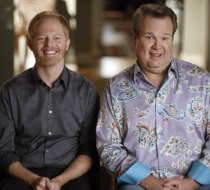Cameron and Mitchell Favorite
‘Modern Family’ Finale: How Cameron and Mitchell Forever Changed Gay Families on TV
The groundbreaking ABC sitcom came to a conclusion this week, forever leaving its mark on the LGBTQ television landscape.
Jude Dry
Apr 10, 2020 5:00 pm
When “Modern Family” premiered in 2009, the mockumentary-style family sitcom was an instant hit, one that would forever alter the fabric of the television landscape. At the time, it seemed water cooler discussion of primetime television had gone the way of the radio, but — much like that other medium — it came roaring back. While Sofia Vergara’s Gloria waltzed her way into the hearts of gay men and lesbians for wildly different reasons, it was Cameron and Mitchell’s loving relationship that made LGBTQ viewers feel truly seen and represented.
Played by Jesse Tyler Ferguson and Eric Stonestreet, seeing a loving (and bickering) gay couple on primetime was a revelation. Without downplaying the strides made by “Will & Grace,” “Modern Family” was the first time a major network had shown a long-term, committed queer relationship — and with two of its leading characters. That the show was funny, smart, and inclusive in other ways was the cherry on top.
To fully grasp the monumental nature of this milestone, it’s imperative to remember that 2009 was the year California’s hateful Prop 8 was passed. Marriage equality would not become the law of the land for another 6 years, with the Supreme Court’s historic Obergefell v. Hodges decision in 2015. At the time of the first season of “Modern Family,” LGBTQ characters accounted for just three percent — 18 total — of all primetime scripted broadcast series regulars. Compare that to the 90 LGBTQ primetime series regulars of 2020, and the power of “Modern Family” is clear.
“Progress can’t be attributed to any one show by itself, but ‘Modern Family’ hit the air at the moment it was most needed and became part of the culture change wave that lead to some of the real-world wins we’ve seen,” said GLAAD’s Megan Townsend. “The series has consistently brought in millions of viewers every week for the past 11 years, and let viewers — particularly ones who may not have been tuning into other inclusive series on cable or streaming — get to know and love a gay couple in all their ups and downs and trials and tribulations.”
One of the most direct examples of the series’ having an effect on real-world attitudes came in 2014, when Cam and Mitch got hitched in the Season 5 finale. Over 10 million viewers tuned in for the wedding, and the very same day a new Gallup poll announced that support for marriage equality had reached a new high.
When Cam and Mitchell adopt a daughter in Season 1, “Modern Family” reached yet another milestone, paving the way for the positive portrayal of LGBTQ families on TV. Shows such as Freeform’s “The Fosters” and NBC’s “The New Normal” were able to show LGBTQ parents and families being loving and supportive. In 2011, “Grey’s Anatomy” favorites Callie and Arizona adopted a baby.
More recently, LGBTQ parents have appeared where its influence will be felt even more deeply: Children’s programming. In 2017, the groundbreaking Disney show “Doc McStuffins” featured an interracial lesbian couple as two moms, voiced by out lesbians Wanda Sykes and Portia de Rossi. Hulu debuted “The Bravest Knight” last year, an animated fairy tale about a gay dad recounting his adventures to his adopted daughter.
While it’s impossible to say exactly how much of this progress is owed to “Modern Family,” the show’s reach, popularity, and endurance coincided with LGBTQ visibility on TV advancing in leaps and bounds.
“We know that representation matters,” said Townsend. “The entertainment we see on screen can shape the world around us through education, sharing new stories, seeing yourself reflected in a way that empowers you or finding common ground with people you might not have before.”







